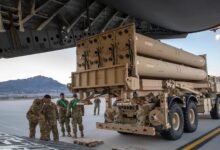US Mulls Sending “Lethal” Air-To-Air Aim-120 Missiles To Ukraine To Turn The Tables On Russia

- The whole computer system would have to be changed, and wiring for the AIM-120 AMRAAM would have to be added to Ukrainian fighter planes like the MiGs and Sukhois.
- With its long range, an active radar missile would pose a serious threat to any Russian planes that tried to fly into a battle zone.
The US military is looking into whether or not it is possible to combine advanced Western air-to-air missiles with Ukraine’s fighter jets. This is part of a recent effort to update old platforms with modern capabilities in preparation for what is expected to be a bloody spring.
Two anonymous defence department officials and another person involved in the talks were quoted in the report as saying that officials are thinking about putting AIM-120 medium-range advanced air-to-air missiles on Ukraine’s MiGs.
These reports come at a time when Ukrainian officials are trying harder to get US lawmakers to send modern F-16 fighter jets that can handle battle. Two Ukrainian fighter pilots were in the United States to get evaluated for their training.
The Ukrainian Air Force uses old fighter jets from the Soviet era, which are often shot down by Russian warplanes using long-range air-to-air missiles to attack from their airspace.
Even though neither side has control of the air, Kyiv needs modern air power to compete with the more advanced and larger Russian Aerospace Forces (VKS).
This is where the idea of putting AIM-120 missiles on jets from the Soviet era comes in. If the project works, the US will give Ukrainian planes the ability to fire these advanced air-to-air missiles for the first time.
The Ukrainian military already has AIM-120s that can be used as surface-to-air missiles, and it can use the supply lines that are already set up for these weapons.
The US has also sent air-to-ground missiles like the AGM-88B High-speed Anti-Radiation Missile, which can be mounted on Ukraine’s MiG fighters and used against ground targets like radars and air defence systems.
The Pentagon has also given them the Joint Direct Attack Munition (JDAM), which turns weapons dropped from the air into smart bombs.
But when the AIM-120s are put on MiGs, it will be the first time that the US has air-to-air missiles that can be fired from planes. But the US plan and examination, as clear and ambitious as they are, are also full of problems, and experts think it might be too good to be true.
Intelligence officials from the West and Ukraine have also warned that Russia is already getting ready for a huge spring offensive. It is unlikely that the US would be able to give Ukrainian fighter jets AIM-120 missiles, which are often found on newer US Air Force warplanes like the F-35 stealth fighter jet, which is of the fifth generation.
Herculean Task
A Pentagon officer and another person with first-hand knowledge of the project both The process of integrating the systems is difficult. The sources said that the missile not only has to be attached to the plane, but it also has to be able to talk to the plane’s radar.
The radar on the plane guides the missile until it is close enough to the target. Only then does it fire it. The main problem is that the American and Soviet systems are so different that the missile and aircraft can’t talk to each other.
“How do you mount this thing?” is something the military is working on. Can you get the plane’s electronics to talk to this thing that wasn’t meant to fly?” one of the US Department of Defense officials said (DoD).
Lt. Col. Garron Garn said, “We talk to the leaders of Ukraine on a regular basis, and we’ll keep talking with them about their security needs, both in the short term and in the long term.” “Our main goal will still be to give the Ukraine real combat capabilities so they can defend their country. However, for operational security reasons, we won’t talk about what steps we may or may not be taking in this effort.”
Also, it needs to be in constant contact with the plane that launched it for it to work well over long distances. But Ukraine’s fighter jets don’t have Soviet-made radars with enough range to fully use the AIM-120’s range, as a Ukrainian pilot said in The War Zone.
Abhijit Iyer Mitra, a military expert and senior fellow at the Institute for Peace and Conflict Studies (IPCS), “It can be done, but it is not a quick project, and it will probably take a few years.” The whole computer system would have to be changed, and wiring for the AIM-120 AMRAAM would have to be added to Ukrainian fighter planes like the MiGs and Sukhois.
“It’s not just a matter of integrating the missile with the electronics of these warplanes. They also need tramps for the missile racks of the Ukrainian fighter jets that match the notches on the missile.
“They will make an interface and figure out how information will move. It has a lot of problems and complications, and it will take at least four to five years to make it work. After that, all the testing for compatibility will have to be done.”
Still, if the US Air Force figures out quickly how to put these AMRAAMs on Ukrainian jets, the Ukrainian Air Force will have a powerful weapon to use against Russian planes and helicopters.
Earlier, there were rumours that the Russian Air Force had put together combat helicopters and fighter jets along the border with Ukraine, which could mean that an air raid is coming soon. But if the Ukrainians have AIM-120s, these attacks from the air could be stopped.
With its long range, an active radar missile would pose a serious threat to any Russian planes that tried to fly into a battle zone. Near the front lines, it would be very hard to fly planes. The AMRAAM could also shoot down drones and cruise missiles that were low in the air.







Facebook Comments